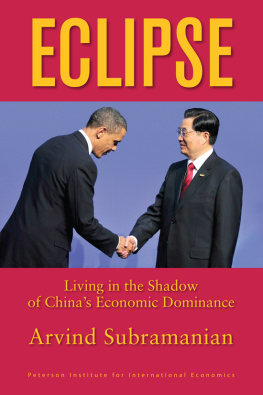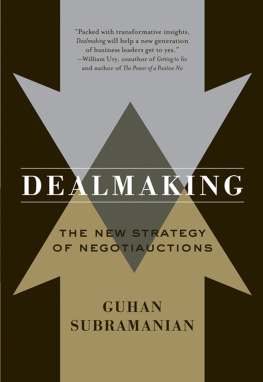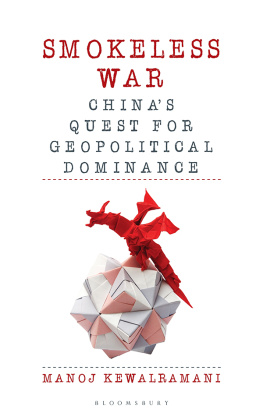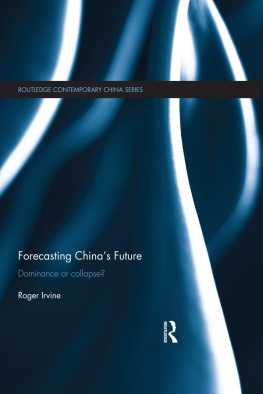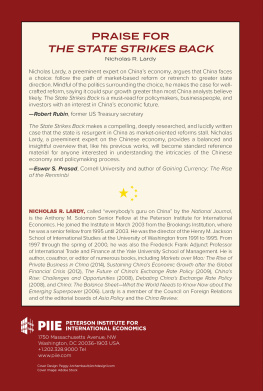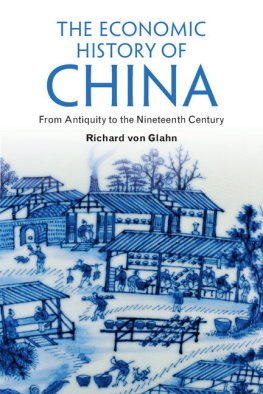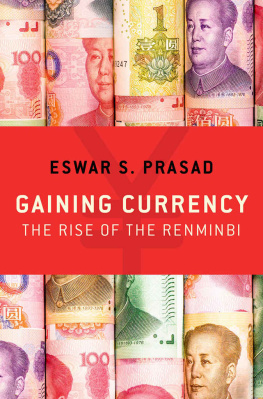ECLIPSE
Living in the Shadow of
Chinas Economic Dominance
Arvind Subramanian
PETERSON INSTITUTE FOR INTERNATIONAL ECONOMICS
Washington, Dc
september 2011

Arvind Subramanian is senior fellow jointly at the Peterson Institute for International Economics and the Center for Global Development. He was assistant director in the Research Department of the International Monetary Fund. He served at the GATT (198892) during the Uruguay Round of trade negotiations and taught at Harvard Universitys Kennedy School of Government (19992000) and at Johns Hopkins Universitys School for Advanced International Studies (200810). He advises the Indian government in different capacities, including as a member of the Finance Ministers Expert Group on the G-20. His previous books include Indias Turn: Understanding the Economic Transformation (2008) and Efficiency, Equity, and Legitimacy: The Multilateral Trading System at the Millennium (2002).
PETER G. PETERSON INSTITUTE FOR INTERNATIONAL ECONOMICS
1750 Massachusetts Avenue, NW Washington, DC20036-1903
(202) 328-9000
FAX: (202) 659-3225
www.piie.com
C. Fred Bergsten, Director
Edward A. Tureen, Director of Publications, Marketing, and Web Development
Typesetting by BMWW
Printing by United Book Press, Inc.
Cover design by Sese-Paul Design
Cover photo:Ron Sachs/Pool/CNP/Corbis
Author photo by Jeremey Tripp
Copyright 2011 by the Peter G. Peterson Institute for International Economics. All rights reserved. No part of this book may be reproduced or utilized in any form or by any means, electronic or mechanical, including photocopying, recording, or by information storage or retrieval system, without permission from the Institute.
For reprints/permission to photocopy please contact the APS customer service department at Copyright Clearance Center, Inc., 222 Rosewood Drive, Danvers, MA 01923; or email requests to:
Printed in the United States of America
13 12 11 5 4 3 2 1
Library of Congress Cataloging-in-Publication Data
Subramanian, Arvind.
Eclipse : living in the shadow of Chinas economic dominance / Arvind Subramanian.
p. cm
Includes bibliographical references.
1. Economic developmentChina. 2. Economic developmentUnited States. 3. Economic forecastingChina. Economic forecastingUnited States. International economic relations.
I. Title.
HC427.95.S862 2011
330.951dc23
2011030066
The views expressed in this publication are those of the author. This publication is part of the overall program of the Institute, as endorsed by its Board of Directors, but does not necessarily reflect the views of individual members of the Board or the Advisory Committee.
To
Parul,
Tia, Kartikeya, and Rohan, and
My parents
Contents
Tables
| Roles of an international currency |
| Determinants of reserves, 18992009 |
| Convergence and growth rates over time, 18702008 |
| Growth projections in a convergence scenario, 201030 |
| Economic weight in 2010 and 2030 under the convergence scenario |
| Relative rankings of countries under the convergence scenario with GDP measured in purchasing power parity dollars |
| Relative rankings of countries under the convergence scenario with GDP measured in dollars |
| Share of world trade under the convergence scenario, selected countries, 2010 and 2030 |
| Exports between countries as a share of total world exports, 2008 and 2030 |
| Demographic and economic weight of the populous poor, 15002030 |
| UK, US, Chinese, and European shares of world GDP measured in purchasing power parity dollars, 18702030 |
| UK, US, Chinese, and European shares of world trade, 18702030 |
| UK, US, Chinese, and European shares of world net capital exports, 18702030 |
| UK, US, Chinese, and European GDP per capita, 1870, 1950, and 2030 |
| Trade patterns of economically dominant powers in history |
| Comparing mercantilist outcomes and instruments of economic powers in history |
| Twenty-year growth rate of selected economies after reaching 25 percent of US GDP per capita |
| Long-run growth rates of economies before and after reaching 25 percent of US GDP per capita |
| Who is in charge? 18702030 |
Figures
| Military expenditures of economically dominant powers, 18702009 |
| Public debt in the United Kingdom, United States, and Germany, 16922010 |
| Economic dominance index from 1870 to 2010 for the top three countries using IMF weights |
| Economic dominance index from 1870 to 2010 for the top three countries using reserve currency weights |
| Holdings of reserve currencies, 18992009 |
| Association between reserve currency and GDP, 18992009 |
| Association between reserve currency and trade, 18992009 |
| Association between reserve currency and net creditor status, 18992009 |
| Broadening convergence: Percent of all nonoil, nonsmall developing countries with GDP per capita growth rates above the US growth rate, 19502007 |
| Accelerating convergence: Average of excess of GDP per capita over US growth for all nonoil, nonsmall developing countries with growth above that of the United States, 19502007 |
| Per capita GDP of the populous poor relative to the economic frontier, 15002008 |
| Impact of OECD growth on non-OECD growth |
| Economic dominance index from 1870 to 2030 for the top three countries under the convergence scenario using IMF weights |
| Economic dominance index from 1870 to 2030 for the top three countries under the convergence scenario using reserve currency weights |
| Economic dominance index from 1870 to 2030 treating the European Union as a single political unit under the convergence scenario using IMF weights |
| Economic dominance index from 1870 to 2030 treating the European Union as a single political unit under the convergence scenario using reserve currency weights |
| Share of sterling relative to dollars in bond issuance by Argentina, Brazil, and Chile, 18701939 |
| History and possible timeline of future reserve currency transition, 18702022 |
| Robustness of economic dominance index to weighting, 2030 |
| Trade-to-GDP projections for the United States, China, and the world, 19702030 |
| Economic dominance in a scenario where America is resurgent, projection to 2030 |
| Economic dominance in a scenario where Chinese growth collapses, projection to 2030 |
| Economic dominance in a scenario where China is resurgent, projection to 2030 |
Boxes
| Goldman Sachs or Citigroup: Whose growth projections are right? |
| Is China already number one? |
| Mercantilism and mercantilist confusion in history |
| Has Chinese mercantilism shortchanged Chinese consumers? |
| Limits to international monetary cooperation |
Preface
The Peterson Institutes research and publications over the years have focused to a considerable extent on China and its economic rise. One of the early books in this regard was Nicholas Lardys China in the World Economy (1994) followed most notably by

